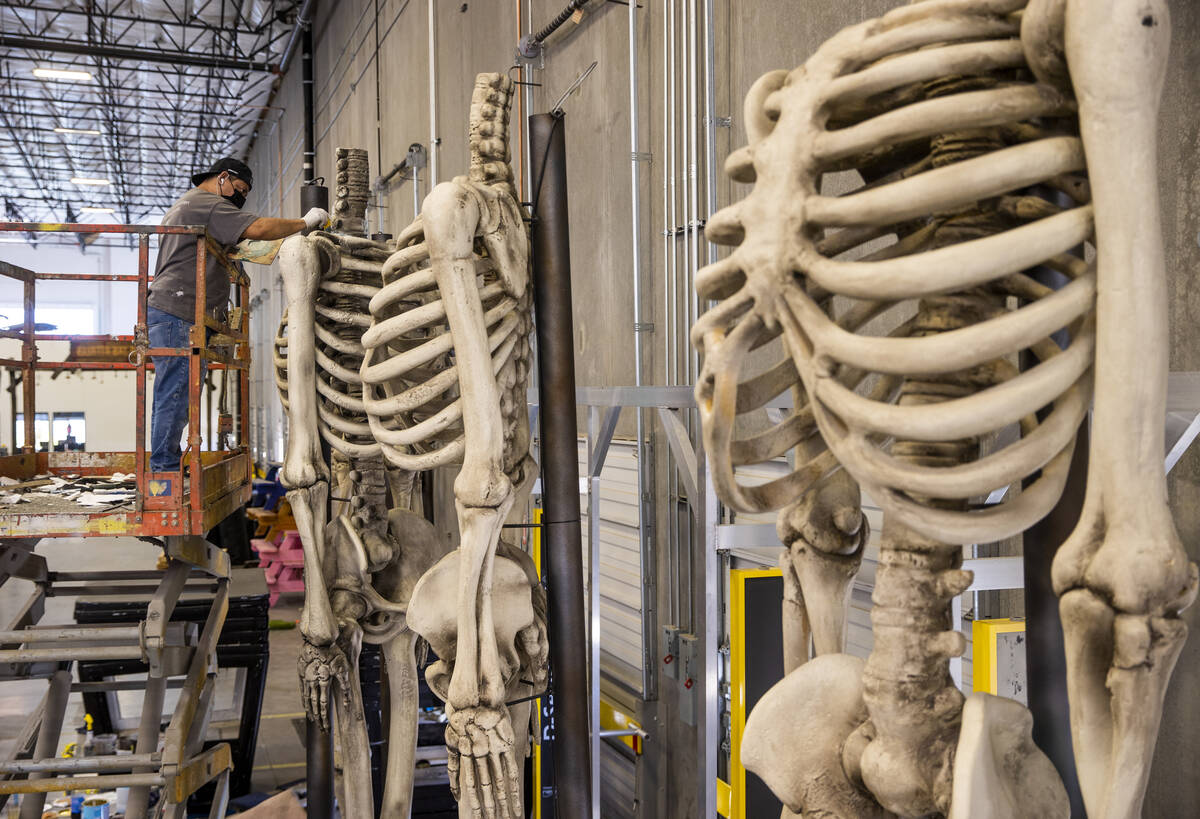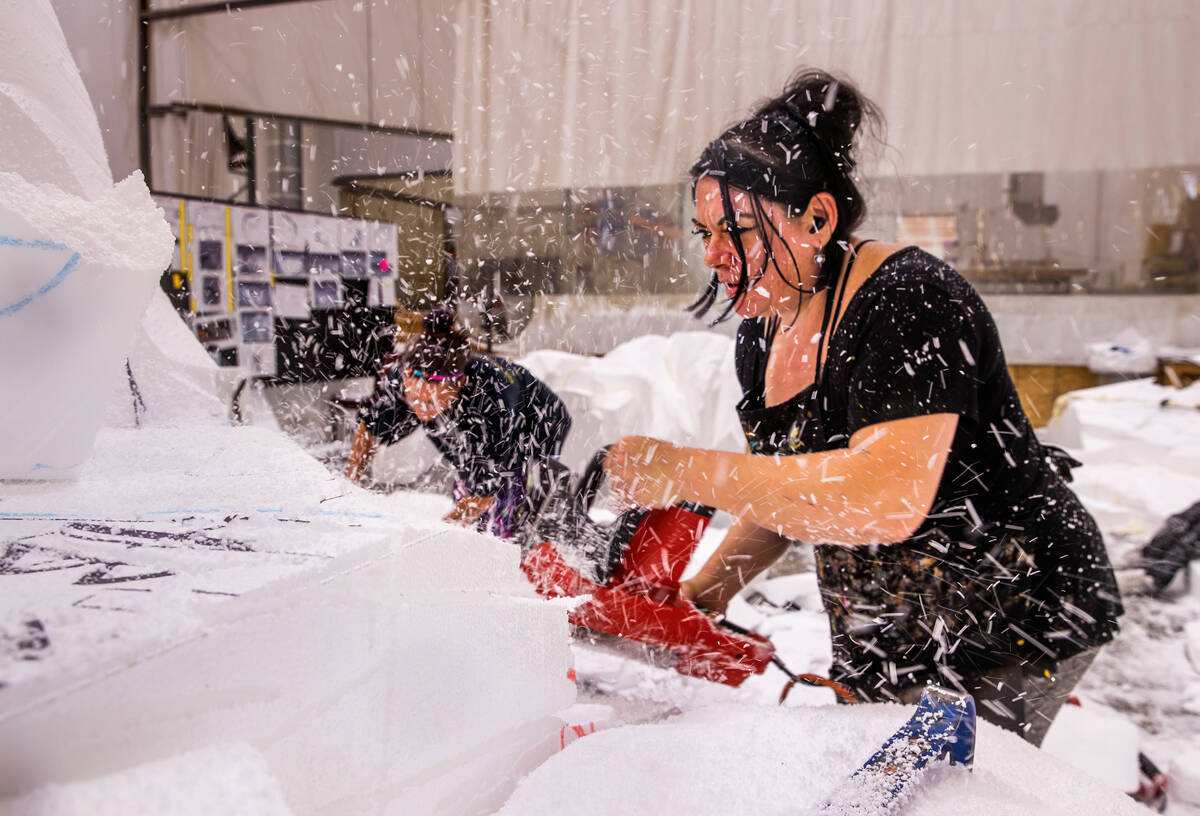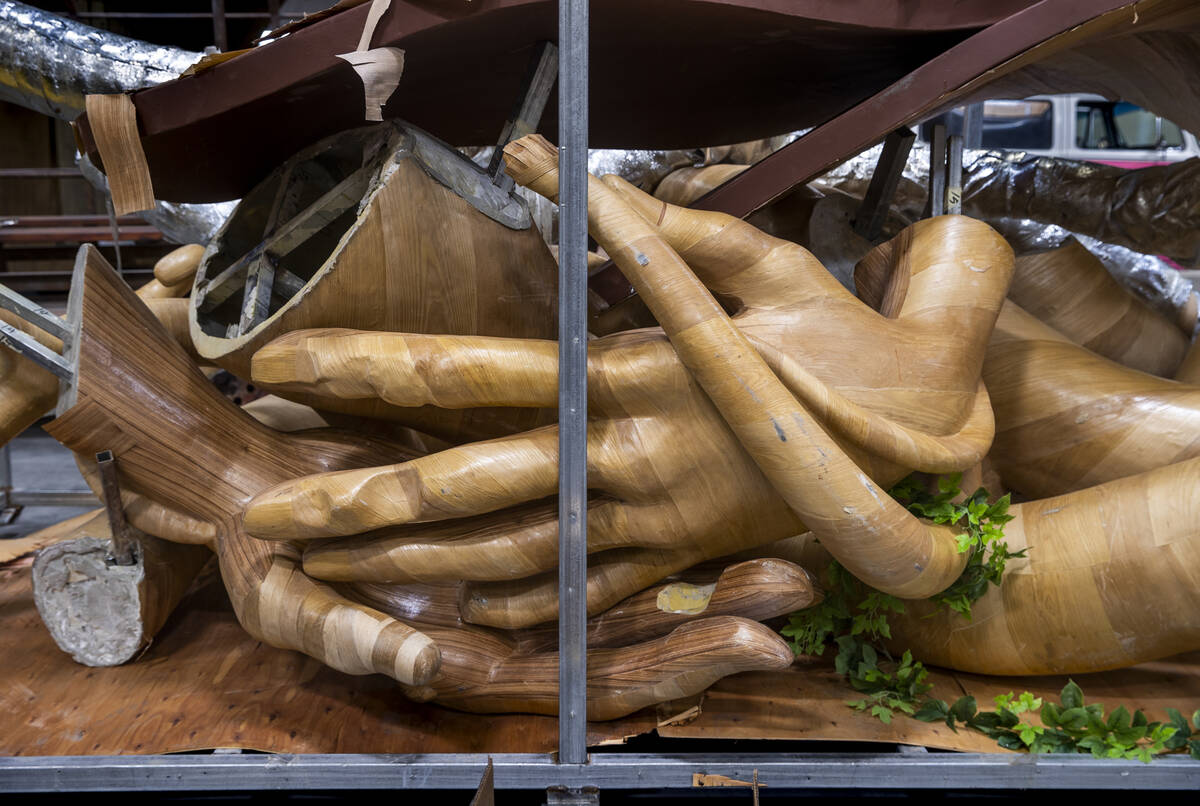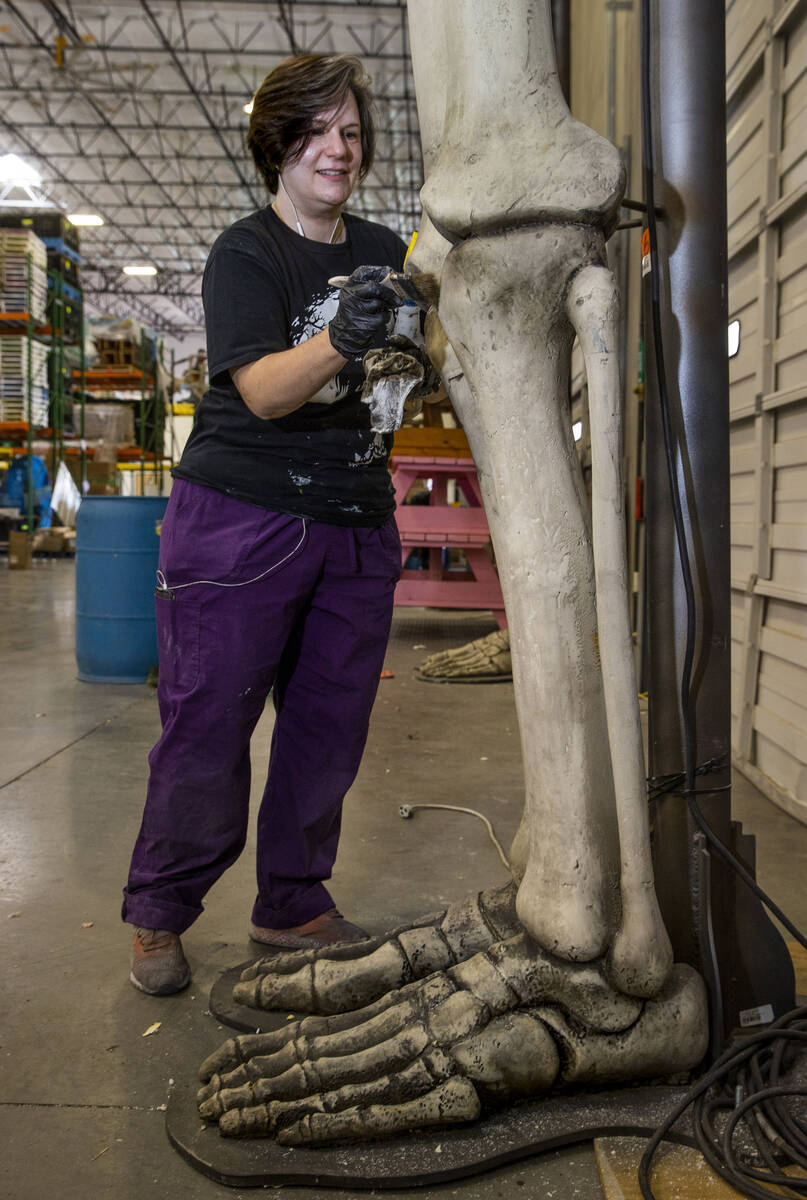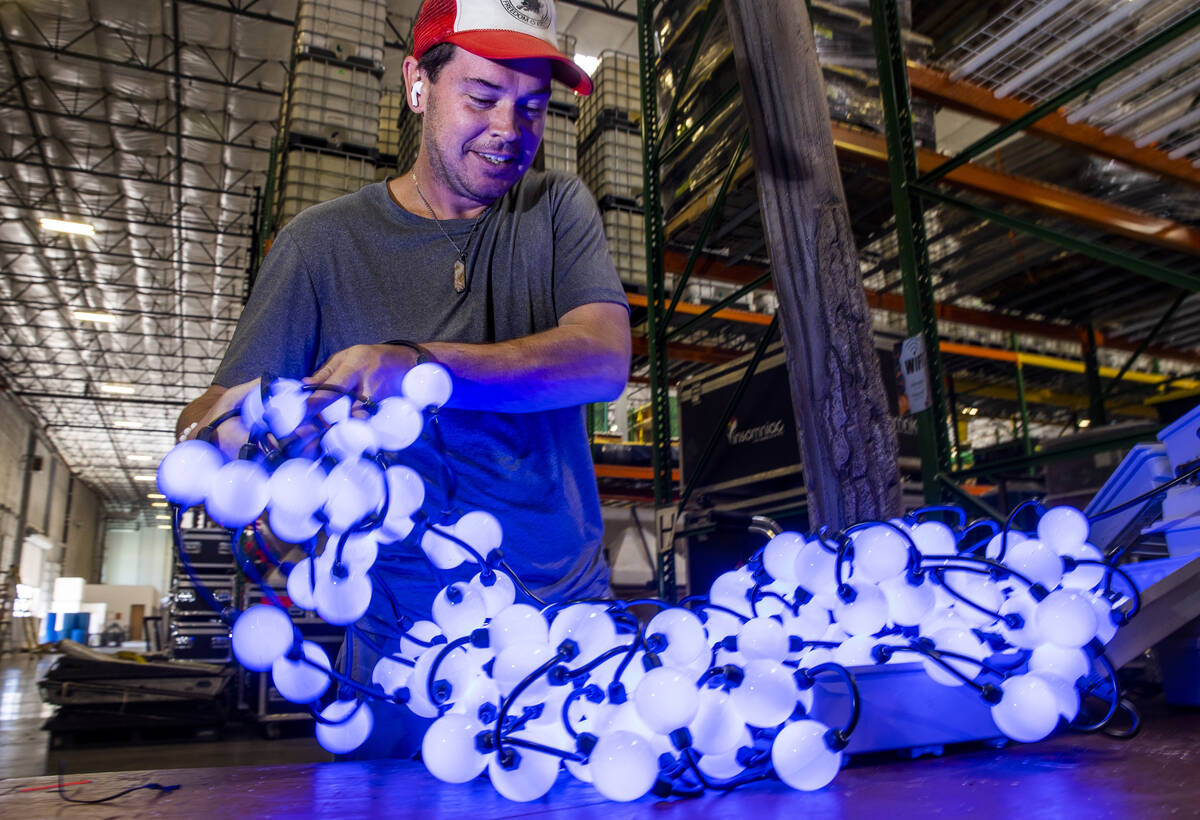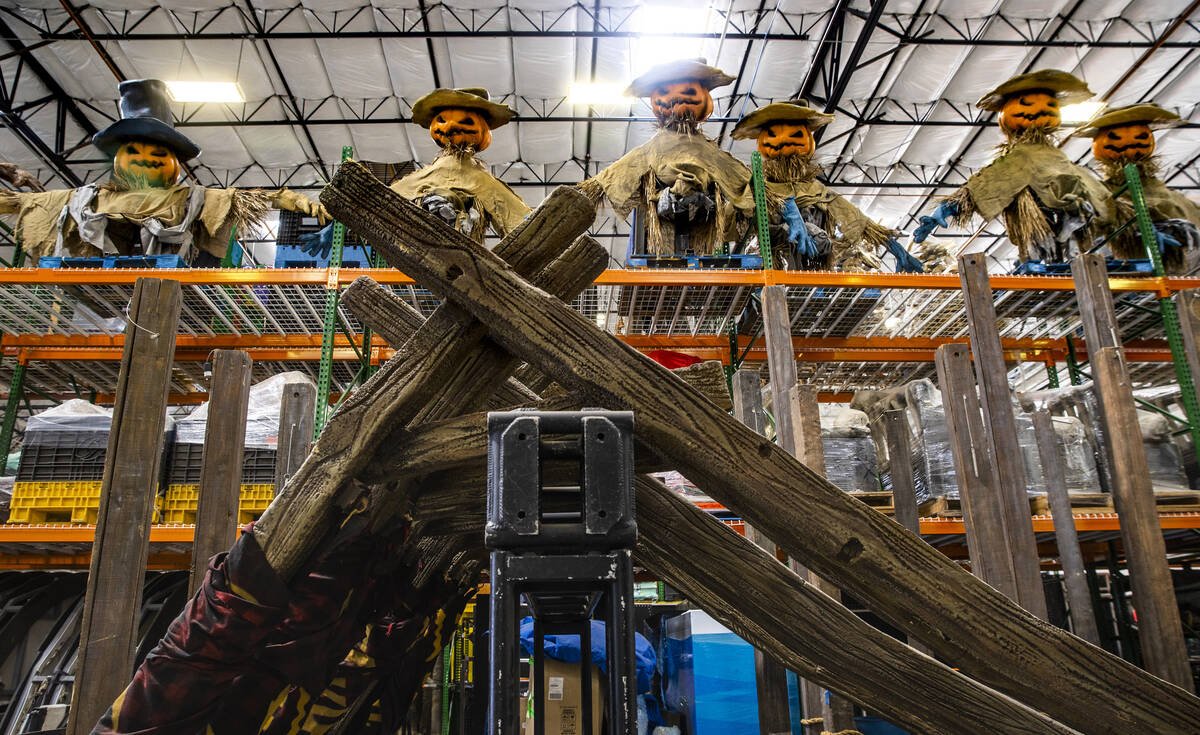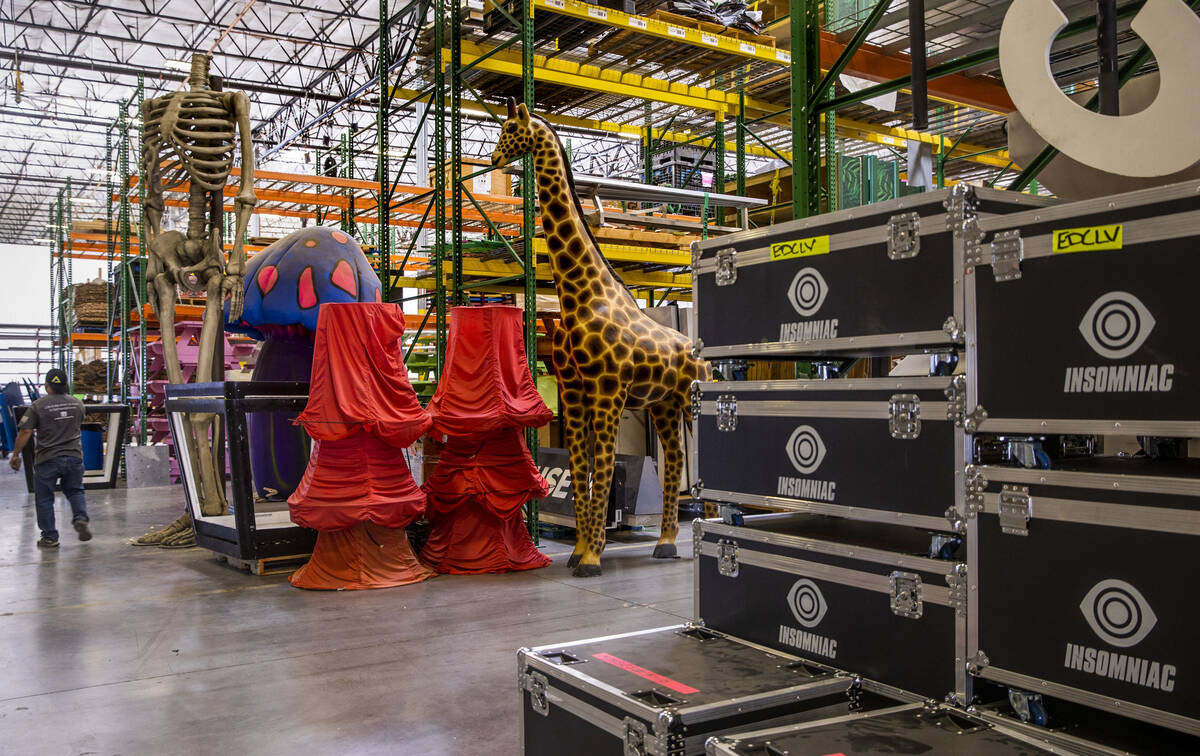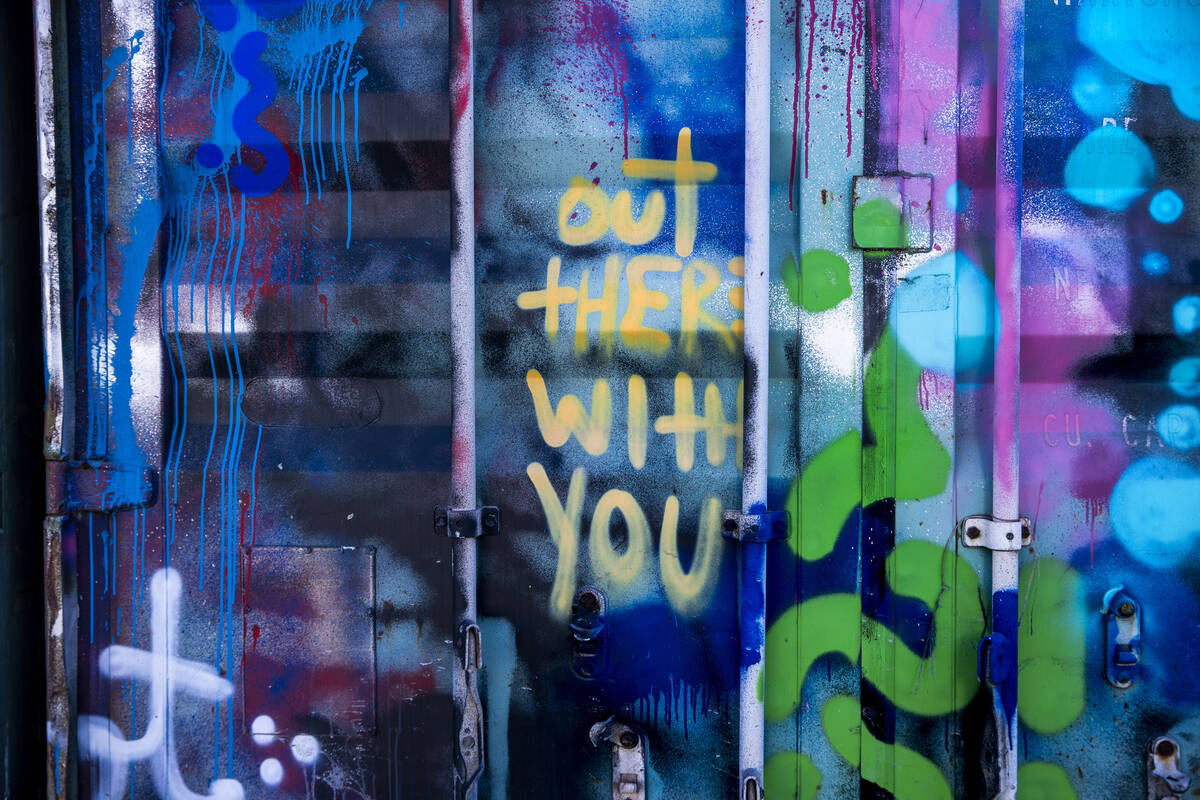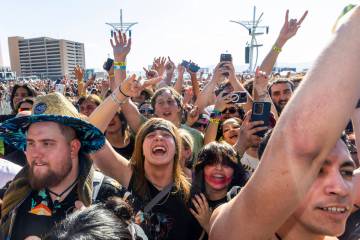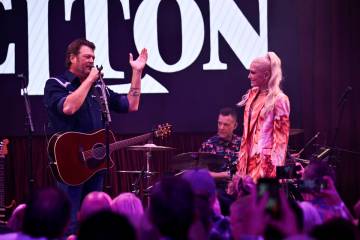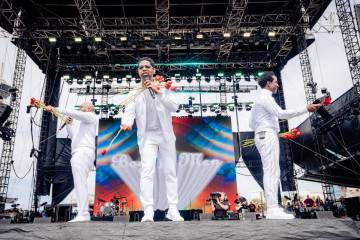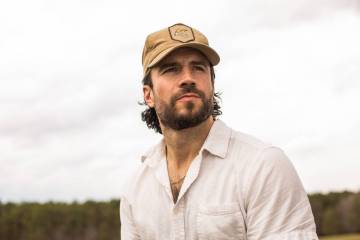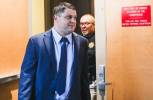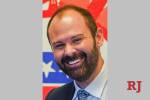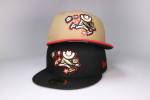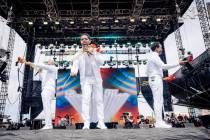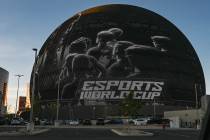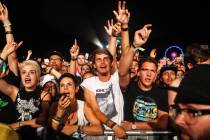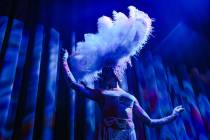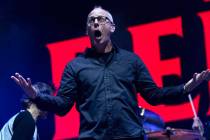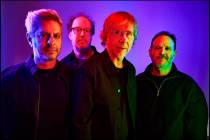A behind-the-scenes look at what it takes to put on the EDC
To think, this all started in a bedroom, this fantasyland of windmill-tall skeletons, boulder-big disco balls and rainbow-colored mushrooms the size of an earthmover’s hubcap.
Twenty-five years later, you need wheels to navigate this 200,000-square-foot maze of manufacturing and memories in North Las Vegas, where all the outsize visual flourishes and one-of-a-kind props for the world’s biggest dance music festival are both housed and often made.
On cue, a bearded fellow piloting a pink bicycle zips by.
“That’s one thing we do: We ride bikes, skateboards,” observes Marina Chairez, senior director of creative experience for Insomniac Events on a sunny afternoon last month. “I like to walk because I like to get my steps in, but the bike is definitely the more efficient way of getting around the shop.”
Electric Daisy Carnival blossoms back to life Friday at Las Vegas Motor Speedway after a 2½-year hiatus due to the pandemic, expected to draw more than 450,000 fans to the three-day event that’s pumped over $2 billion into the Las Vegas economy since debuting here in 2011.
It’ll mark the 10th anniversary of EDC coming to Vegas — and its 25th year overall.
Since debuting at Los Angeles’ Shrine Expo Hall in 1997, Electric Daisy Carnival has developed into one of the most unique, over-the-top festival experiences there is, a Disney World of dance music, a dusk-till-dawn deluge of light and sound, fireworks and fuzzy boots.
“It’s like a dream, like a magical paradise you enter,” says superstar DJ-producer Tiesto, who’s the only artist to perform at every one of the Vegas EDCs. “The energy there, everybody’s very happy. It’s just very peaceful, and of course, (there’s) amazing music and amazing different experiences you can have. If you walk around EDC, there’s so many different things to do and see. It’s just really special.”
And it’s here in this warehouse where EDC’s seeds are planted, where it — and all other Insomniac shows — begin taking physical shape.
“It’s a global force that comes out of this little building,” Chairez notes. “This is the hub, really.”
Well, we wouldn’t really call it “little”: At EDC’s much smaller previous warehouse near the speedway, four people were employed; this building boasts a staff of 100.
“Watch your step, we’re actively loading trailers,” Chairez directs, flanked by Jason Cooper, founder of Gist Specialties fabrication company, who now runs his business out of this place.
“They’re expecting 150-plus trucks of stuff out of the warehouse,” explains Cooper, who does much of EDC’s fabrication work. “That’s not including the 140 trailers full of product that’s not even in this building.”
Insomniac is awakening from the pandemic at full speed. They’re doing this year’s two biggest productions, EDC Las Vegas and San Bernardino’s Escape Halloween, on consecutive weekends, followed by another large show, EDC Orlando, 10 days after that.
“We’re putting a lot in a shortened window,” Chairez says. “We’re pushing hard, but we always find a way. The show always finds a way.”
That the show would find its way to Vegas 10 years ago, though, was not a given.
‘A huge risk’
The helmeted Parisians served as a potentially ominous warning sign.
Flashback to EDC 2010: After a controversy-plagued outing at the Los Angeles Memorial Coliseum, where there were overcrowding issues and a 15-year-old died from an ecstasy overdose, Insomniac Events founder Pasquale Rotella needed to find a new home for Electric Daisy Carnival.
It was the flagship event of the company he started while living in his mother’s Southern California home in the ’90s, his bedroom — and later the garage — doubling as his office.
But where to move it?
Back then, Vegas was a suspect market for big-tent music festivals.
There was the Viva Las Vegas rockabilly weekender and Punk Rock Bowling, both popular draws within their respective scenes, but they catered to niche markets.
Perhaps the most notable attempt at putting on a large-scale fest here was the alt-rock-leaning Vegoose, which debuted at Sam Boyd Stadium in 2005 and lasted three years.
During its final run in 2007, Vegoose boasted a stacked lineup headlined by a newly reunited Rage Against the Machine and robot headgear-sporting electronic music duo Daft Punk.
And it still wasn’t enough to make the fest financially sustainable.
“Vegoose was an event that I closely watched,” Rotella recalls, “and that was one of the ones that was my biggest deterrent because they had Daft Punk and it didn’t cut it.
“I was like, ‘They have Daft Punk and it didn’t do the number?’ ” he continues. “That really was like, ‘Hmmm, is this really the right decision? The kings of electronic music not pulling the scene there?’ ”
This is a city posited on taking chances, and true to the setting, coming here amounted to a serious roll of the dice for Rotella.
“It was one of the hardest decisions I’ve ever had to make for the company,” he acknowledges. “There were options, and Vegas was a huge risk.
“But I just felt like it was such a great destination,” he continues, “easy to come in and out. I wanted people from all over the world to travel to EDC; Vegas is set up for tourism. The hotels are not far from the airport. The city is all about entertainment.”
Still, there were reservations, locally.
When Rotella met with hotels about working with EDC, they recalled the chaos of the 2007 NBA All-Star Game, when the festivities came to Vegas and resulted in over 400 arrests and a strip club bouncer getting shot and paralyzed below the waist.
Then-Mayor Oscar Goodman branded it a “disastrous weekend” afterward.
With the all-star game fallout still fresh on their minds, the hotels initially took a wait-and-see approach to EDC.
“They were like, ‘You better be careful, because this town will never accept that event to come back here again,’ ” Rotella remembers. “I said, ‘I promise you it: This is nothing like that.’ They said, ‘OK, we’ll pass on this year, but we’ll see how it goes.’ ”
It went smashingly, attracting over 230,000 fans to the speedway while avoiding the mayhem that marred its last year in L.A.
Still, while EDC was a big draw from day one in Vegas, it also came with a bigger overhead — in the fest’s first four years here, Insomniac spent over $150 million.
EDC was far from an instant moneymaker for Rotella — in fact, it was the opposite.
“I felt good about the response from the community that supports us, the scene,” Rotella says of EDC’s Vegas debut, “but it was also challenging for me, because I was on my own financing this thing and I had lost — or invested, however you want to look at it — millions of dollars that first year.
“It wasn’t a home run,” he continues. “It was yet to be seen how it was going to play out, but I had a vision of it being successful. I thought it was good enough to keep being able to draw people and grow — and it took years to kind of get to a place where it made sense. I had confidence in it, so I kept pushing. I believed.”
He wasn’t alone.
“I knew it was going to work right away, actually — it’s really true,” Tiesto says. “I knew it, because Vegas is the perfect city to host things like this. What other city can put 100,000 people in hotel rooms for a weekend? To have a venue 20 minutes away for the biggest rave in the world?
“I think Vegas was so much better for them than it was in L.A.,” he continues, “ ’cause in L.A. there was always struggling and the rules were very different. I think it was the best move Pasquale ever did, to move EDC to Vegas.”
Bringing EDC to life
The chainsaw chews into an emerging Styrofoam landscape, the woman wielding it looking as if she’s standing inside a snow globe of low-fidelity carbon foam.
Another creation is coming to life in the Insomniac warehouse.
Jason Cooper stops near an array of two-story-high Halloween props.
“A lot of people don’t understand what it takes to build a 20-foot skeleton,” he notes, “how many hours, the brainpower, the stresses and everything else.”
Oh, but Cooper does.
The Pahrump native possesses years of experience in the theme park industry, having done work for Disney and plenty of others.
What made him want to join forces with Insomniac?
“I love punishment,” he says jokingly — maybe. “ ‘Oh, he likes the (crap) beat out of him. He’ll be perfect.’ ”
Cue the giant prefabricated plants, one of Cooper’s early projects for Insomniac.
“The first thing we pulled off was just some big daisy flowers,” he recalls. “The scale got exaggerated more than what we were supposed to build to start with, ‘Put more water on the flowers because they need to be bigger. You don’t understand the environment they’re going in.’
“When you’re in the shop and you’re looking at them,” he continues, “you’re like, ‘I don’t know, bro, they’re pretty big.’ But then when you deliver them out to the site and they start putting up the stages and you look around, you’re like, ‘Oh that stage is 100 feet tall.’ ”
Creating props for EDC and other Insomniac productions is markedly different from the various installation pieces his company has made for the Strip and elsewhere.
“It was definitely a little bit more of a learning curve in the beginning because it’s not permanent, it needs to last three days,” Cooper explains. “How do you put it up in hours, make it last three days, and then take it back down in hours?
“All the time, we’re trying to figure out: ‘How big does it need to be, what’s the finish, how many times are they going to use it?’ ” he continues. “ ‘Is this part of the touring festival where it goes around the world, so it’s gotta go in the semitruck or a container and you’ve got to let the Chinese install this thing and they can’t read your instructions?’ ”
Insomniac employs a design team based out of the Netherlands, Leisure Expert Group, to conceptualize the various attractions and set pieces for their events.
They generally start working on a new EDC years in advance.
“That’s how much time it takes,” Chairez says. “It needs to be three, four, five years out in order to give us the time to start building some of the things.”
The idea is that fans never experience the same EDC twice.
“It has to be new for them every year,” Chairez says. “What are we going to do this year that we didn’t do last year. How are we going to make it better? Certainly, something new is coming out of the shop every year.”
The Carnival’s comeback
The crew of 100 became a crew of 12.
When the pandemic hit, it came right as Cooper, Chairez and company were moving into their new warehouse in March 2020.
They had to drastically reduce their staff for a time.
There was just no work.
“We went down to almost nothing,” Cooper says. “We spent quite a while just trying to basically milk our way through the pandemic in the beginning, just setting up shop. Every time you ever thought about something, it was like, ‘That ain’t happening.’ ”
Insomniac started doing livestreams, which at least enabled them to construct small sets, albeit with limited funds.
“There was no spending,” Chairez says. “We had to still create products on minimal budgets, minimal people, ‘All right, what do we have in the warehouse that we can give a fresh coat of paint or change up a little bit?’ That’s how we survived.”
They weathered the storm, though, and now they stand in the eye of a tornado of activity.
The shelves here are still packed.
They won’t be for long.
“By the time Vegas is in full swing and we’re loading out for Escape,” Cooper observes, “this warehouse will probably be about 90-95 percent empty.”
Getting to this point wasn’t easy.
There were false starts: Normally held in May, EDC’s return was originally announced for October 2020, only to be bumped to the following May.
In April, Rotella confirmed that the fest was still on, before having to reverse course two weeks later and postpone the event once again, earning the ire of some fans who felt that didn’t give them enough time to change travel plans and get reimbursed for flights and hotels.
Still, demand has remained strong for EDC: All tickets for the 2021 show were snapped up in 12 hours when they went on sale last August.
What’s new for 2021?
In addition to having to provide proof of vaccination or a negative COVID-19 test upon entry each day, EDC’s biggest-ever crowd will experience the fest’s biggest-ever footprint.
“This will be our largest EDC Las Vegas in the history of EDC,” Rotella says. “The rhythm is always changing, there’s new ideas.
“EDC needs to be different every time,” he continues. “Our work will never be done.”
Back at the warehouse, Rotella’s words come to life in the clang of machinery and the growl of engines.
“Trucks load here, trucks load there, trucks load everywhere,” Chairez chimes.
Rotella wants to turn a portion of this place into a quasi-museum someday.
“I want to get the warehouse to a level where we tour, like, students,” he says, “and it’s like, ‘Wow,’ like walking through a really good Halloween store, but for our different events.”
Until then, the next event beckons.
Chairez scans her surroundings.
She seems a little incredulous about it all — it’s the only thing little here.
“This started as an idea in a small place,” she says, standing beneath a ceiling taller than Pasquale Rotella’s childhood house, “and it’s grown to something massive.”
Contact Jason Bracelin at jbracelin@reviewjournal.com or 702-383-0476. Follow @jbracelin76 on Instagram



